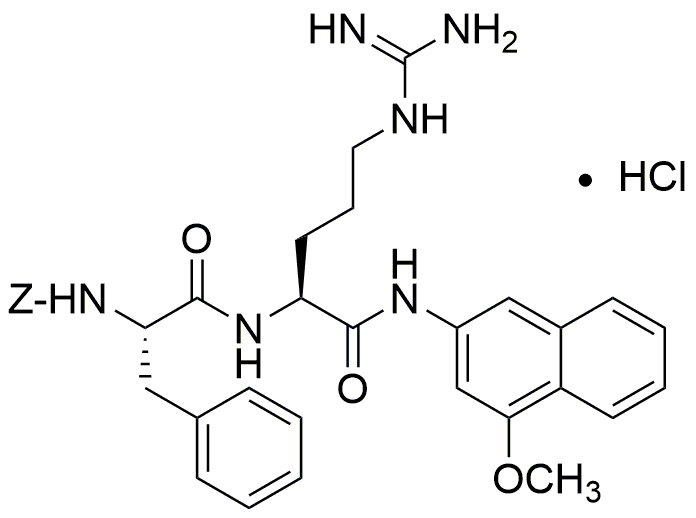Z-Phe-Arg-4MbNA·HCl is widely utilized in research focused on:
- Peptide Synthesis: This compound serves as a key building block in the synthesis of peptides, particularly in the development of therapeutic agents and biologically active molecules.
- Drug Development: It plays a significant role in pharmaceutical research, especially in designing drugs that target specific biological pathways, enhancing efficacy and reducing side effects.
- Bioconjugation: The compound is used in bioconjugation processes, allowing researchers to attach drugs or imaging agents to biomolecules, which is crucial in targeted therapy and diagnostics.
- Protein Engineering: It aids in the modification of proteins to improve their stability and functionality, which is essential in creating more effective enzymes and therapeutic proteins.
- Research in Cancer Therapy: This chemical is being explored for its potential in cancer treatment, particularly in the development of targeted therapies that can selectively attack cancer cells while sparing healthy tissue.
General Information
Properties
Safety and Regulations
Applications
Z-Phe-Arg-4MbNA·HCl is widely utilized in research focused on:
- Peptide Synthesis: This compound serves as a key building block in the synthesis of peptides, particularly in the development of therapeutic agents and biologically active molecules.
- Drug Development: It plays a significant role in pharmaceutical research, especially in designing drugs that target specific biological pathways, enhancing efficacy and reducing side effects.
- Bioconjugation: The compound is used in bioconjugation processes, allowing researchers to attach drugs or imaging agents to biomolecules, which is crucial in targeted therapy and diagnostics.
- Protein Engineering: It aids in the modification of proteins to improve their stability and functionality, which is essential in creating more effective enzymes and therapeutic proteins.
- Research in Cancer Therapy: This chemical is being explored for its potential in cancer treatment, particularly in the development of targeted therapies that can selectively attack cancer cells while sparing healthy tissue.
Documents
Safety Data Sheets (SDS)
The SDS provides comprehensive safety information on handling, storage, and disposal of the product.
Product Specification (PS)
The PS provides a comprehensive breakdown of the product’s properties, including chemical composition, physical state, purity, and storage requirements. It also details acceptable quality ranges and the product's intended applications.
Certificates of Analysis (COA)
Search for Certificates of Analysis (COA) by entering the products Lot Number. Lot and Batch Numbers can be found on a product’s label following the words ‘Lot’ or ‘Batch’.
*Catalog Number
*Lot Number
Certificates Of Origin (COO)
This COO confirms the country where the product was manufactured, and also details the materials and components used in it and whether it is derived from natural, synthetic, or other specific sources. This certificate may be required for customs, trade, and regulatory compliance.
*Catalog Number
*Lot Number
Safety Data Sheets (SDS)
The SDS provides comprehensive safety information on handling, storage, and disposal of the product.
DownloadProduct Specification (PS)
The PS provides a comprehensive breakdown of the product’s properties, including chemical composition, physical state, purity, and storage requirements. It also details acceptable quality ranges and the product's intended applications.
DownloadCertificates of Analysis (COA)
Search for Certificates of Analysis (COA) by entering the products Lot Number. Lot and Batch Numbers can be found on a product’s label following the words ‘Lot’ or ‘Batch’.
*Catalog Number
*Lot Number
Certificates Of Origin (COO)
This COO confirms the country where the product was manufactured, and also details the materials and components used in it and whether it is derived from natural, synthetic, or other specific sources. This certificate may be required for customs, trade, and regulatory compliance.


